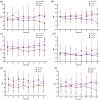The Effect of Tissue Stretching and Release Strategies on Neck Muscles Fatigue and Pain Intensity in Office Workers Affected by Chronic Neck Pain: A Rater-Blind, Semi-Experimental Study
- PMID: 40260041
- PMCID: PMC12010563
- DOI: 10.1002/hsr2.70748
The Effect of Tissue Stretching and Release Strategies on Neck Muscles Fatigue and Pain Intensity in Office Workers Affected by Chronic Neck Pain: A Rater-Blind, Semi-Experimental Study
Abstract
Background and aims: Nonspecific chronic neck pain (ns-CNP) is a common cause of disability among office workers. However, the effectiveness of tissue release and stretching strategies in managing pain and fatigue of neck muscles in employees affected by ns-CNP has not been assessed.
Methods: Thirty-nine employees who suffered from ns-CNP were randomly assigned to stretching, tissue release interventions or control group (n = 13). Neck pain and fatigue in neck extensors, upper trapezius, and sternocleidomastoid muscles were measured during 40 min of typing with a 45-degree head flexion at baseline and immediately after a 6-week intervention using visual analog scale and surface electromyography.
Results: Pain significantly decreased after 6 weeks of both interventions (p < 0.05). There were no significant within-group differences for right cervical muscle fatigue in the intervention groups, but a significant difference was noted in the control group at the 25th and 40th minutes (p < 0.05). Additionally, a significant difference was observed between the release and control group at the 30th, 35th, and 40th minutes (p < 0.05). Left cervical muscle fatigue significantly decreased at the 25th and 40th minutes only for the release group (p < 0.05). A significant difference was observed between the release and control groups at the 40th minute for the right upper trapezius (p < 0.05).
Conclusion: Only the stretching group showed a significant difference with the control in the left sternocleidomastoid at the 10th and 15th minutes, and the release group with the control in the last 5-min. Stretching and release interventions could control neck pain and muscle fatigue in the 45-degree head flexion position.
Keywords: fatigue; foam roller; musculoskeletal dysfunction; neck; pain; trigger points.
© 2025 The Author(s). Health Science Reports published by Wiley Periodicals LLC.
Conflict of interest statement
The authors declare no conflicts of interest.
Figures





Similar articles
-
Immediate Effects of Dry Needing or Manual Pressure Release of Upper Trapezius Trigger Points on Muscle Activity During the Craniocervical Flexion Test in People with Chronic Neck Pain: A Randomized Clinical Trial.Pain Med. 2022 Sep 30;23(10):1717-1725. doi: 10.1093/pm/pnac034. Pain Med. 2022. PMID: 35179608 Clinical Trial.
-
The effects of combined sternocleidomastoid muscle stretching and massage on pain, disability, endurance, kinesiophobia, and range of motion in individuals with chronic neck pain: A randomized, single-blind study.Musculoskelet Sci Pract. 2021 Oct;55:102417. doi: 10.1016/j.msksp.2021.102417. Epub 2021 Jun 12. Musculoskelet Sci Pract. 2021. PMID: 34147954 Clinical Trial.
-
Effects of typing positions on the upper trapezius and neck extensor muscles electromyography in office employees: A single-blind cross-sectional study.Work. 2023;74(1):255-263. doi: 10.3233/WOR-210909. Work. 2023. PMID: 36214012
-
Fatigue changes neck muscle control and deteriorates postural stability during arm movement perturbations in patients with chronic neck pain.Spine J. 2020 Apr;20(4):530-537. doi: 10.1016/j.spinee.2019.10.016. Epub 2019 Oct 28. Spine J. 2020. PMID: 31672689
-
Neck movement and muscle activity characteristics in female office workers with neck pain.Spine (Phila Pa 1976). 2008 Mar 1;33(5):555-63. doi: 10.1097/BRS.0b013e3181657d0d. Spine (Phila Pa 1976). 2008. PMID: 18317202
References
-
- Castellini G., Pillastrini P., Vanti C., et al., “Some Conservative Interventions Are More Effective Than Others for People With Chronic Non‐Specific Neck Pain: A Systematic Review and Network Meta‐Analysis,” Journal of Physiotherapy 68, no. 4 (2022): 244–254. - PubMed
-
- Hirsch T., Wahl U., and Rabe E., “Venous Disorders as an Occupational Disease–A Systematic Review on Epidemiology, Pathophysiology, and Modification Strategies,” Vasa. Zeitschrift fuer Gefaesskrankheiten 53 (2024): 172–184. - PubMed
-
- Collins J. D. and O'Sullivan L. W., “Musculoskeletal Disorder Prevalence and Psychosocial Risk Exposures by Age and Gender in a Cohort of Office Based Employees in Two Academic Institutions,” International Journal of Industrial Ergonomics 46 (2015): 85–97.
LinkOut - more resources
Full Text Sources
Miscellaneous

